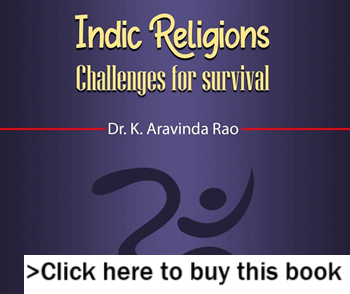God Varuna is one of the supreme deities of the cosmos from the Vedic times and considered responsible for bringing rain, for movement of sun in the sky. Lord Varuna is called as omnipotent and omniscient. He is lord of all water bodies and one of the most prominent deva in Rigveda. In Hindu mythology, Varuna continued to be considered the god of all forms of the water element, particularly the oceans.
Varuna 'the one who econompasses the whole world,' is one of the oldest Vedic deities. May be he is the personification of the sky; but he is also associated with clouds and water, rivers and ocean. He is sometimes clubbed with Mitra and praised (Mitravaruna).
Varuna is the king of the universe and lives in the highest world. His knowledge and power are unlimited. He has thousand eyes and oversees the whole world. Hence he is the lord of the moral law. He punishes those who transgress this law but forgives them out of compassion if they repent and pray. By activating Vayu, the lord of the wind, he sustains life by giving rain and crops.
Though Varuna was the chief deity in the beginning, he seems to have yielded his place later on to Indra and Prajapati.
In the subsequent mythological literature Varuna is described as the presiding deity of the western quarter and as the lord of oceans, water and aquatic animals. In some of the temples he is depicted as riding on a crocodile. In two of his four arms he holds the serpent and the noose (pasa). Sometimes he is pictured as riding in a chariot drawn by seven swans and holding the lotus, the noose, the conch and a vessel of gems in the four hands. There is an umbrella over his head.
Vasus: Vasus are a class of deities, eight in number, chiefly known as attendants of Indra. The word Vasu is derived from 'vas' ('to dwell,' 'to cause to dwell,' 'to shine') and hence Vasus are deities representing all spheres of extension or space, and height. They were perhaps personifications of nature and natural phenomena.
The eight Vasus are: Dhara (the earth), Anala (the fire), Ap (the waters), Anila, (the wind),. Dhruva (the polestar), Soma (the moon), Prabhasa (the dawn) and Pratyusa, (the light).
According to Hindu mythology, Lord Varuna is the son of sage Kashyapa. He is one of the twelve gods acknowledged as Adityas because of their origin from Aditi. Aditi is the mother of gods. He is among one of the oldest Vedic deities. He is embodiment of the sky and associated with clouds, water, rivers, and ocean. In addition to that he is considered to be the sustainer of live by providing rain and crops. He is also considered the lord of dead like lord Yamaraja and could confer immortality if he so chose.
Lord Varuna is depicted as riding in a chariot drawn by seven swans and holding the lotus, noose, conch and a vessel of gems, with an umbrella held over his head. In some temples he is depicted as riding on a crocodile. He is the sustainer of live by providing rain and crops. In the Indian Puranas, Lord Varuna has thousand eyes and oversees the whole world and Hindus worship him in different forms.
Varuna 'the one who econompasses the whole world,' is one of the oldest Vedic deities. May be he is the personification of the sky; but he is also associated with clouds and water, rivers and ocean. He is sometimes clubbed with Mitra and praised (Mitravaruna).
Varuna is the king of the universe and lives in the highest world. His knowledge and power are unlimited. He has thousand eyes and oversees the whole world. Hence he is the lord of the moral law. He punishes those who transgress this law but forgives them out of compassion if they repent and pray. By activating Vayu, the lord of the wind, he sustains life by giving rain and crops.
Though Varuna was the chief deity in the beginning, he seems to have yielded his place later on to Indra and Prajapati.
In the subsequent mythological literature Varuna is described as the presiding deity of the western quarter and as the lord of oceans, water and aquatic animals. In some of the temples he is depicted as riding on a crocodile. In two of his four arms he holds the serpent and the noose (pasa). Sometimes he is pictured as riding in a chariot drawn by seven swans and holding the lotus, the noose, the conch and a vessel of gems in the four hands. There is an umbrella over his head.
Vasus: Vasus are a class of deities, eight in number, chiefly known as attendants of Indra. The word Vasu is derived from 'vas' ('to dwell,' 'to cause to dwell,' 'to shine') and hence Vasus are deities representing all spheres of extension or space, and height. They were perhaps personifications of nature and natural phenomena.
The eight Vasus are: Dhara (the earth), Anala (the fire), Ap (the waters), Anila, (the wind),. Dhruva (the polestar), Soma (the moon), Prabhasa (the dawn) and Pratyusa, (the light).
God Varuna is one of the supreme deities of the cosmos from the Vedic times and considered responsible for bringing rain, for movement of sun in the sky. Lord Varuna is called as omnipotent and omniscient. He is lord of all water bodies and one of the most prominent deva in Rigveda. In Hindu mythology, Varuna continued to be considered the god of all forms of the water element, particularly the oceans.
Varuna 'the one who econompasses the whole world,' is one of the oldest Vedic deities. May be he is the personification of the sky; but he is also associated with clouds and water, rivers and ocean. He is sometimes clubbed with Mitra and praised (Mitravaruna).
Varuna is the king of the universe and lives in the highest world. His knowledge and power are unlimited. He has thousand eyes and oversees the whole world. Hence he is the lord of the moral law. He punishes those who transgress this law but forgives them out of compassion if they repent and pray. By activating Vayu, the lord of the wind, he sustains life by giving rain and crops.
Though Varuna was the chief deity in the beginning, he seems to have yielded his place later on to Indra and Prajapati.
In the subsequent mythological literature Varuna is described as the presiding deity of the western quarter and as the lord of oceans, water and aquatic animals. In some of the temples he is depicted as riding on a crocodile. In two of his four arms he holds the serpent and the noose (pasa). Sometimes he is pictured as riding in a chariot drawn by seven swans and holding the lotus, the noose, the conch and a vessel of gems in the four hands. There is an umbrella over his head.
Vasus: Vasus are a class of deities, eight in number, chiefly known as attendants of Indra. The word Vasu is derived from 'vas' ('to dwell,' 'to cause to dwell,' 'to shine') and hence Vasus are deities representing all spheres of extension or space, and height. They were perhaps personifications of nature and natural phenomena.
The eight Vasus are: Dhara (the earth), Anala (the fire), Ap (the waters), Anila, (the wind),. Dhruva (the polestar), Soma (the moon), Prabhasa (the dawn) and Pratyusa, (the light).
According to Hindu mythology, Lord Varuna is the son of sage Kashyapa. He is one of the twelve gods acknowledged as Adityas because of their origin from Aditi. Aditi is the mother of gods. He is among one of the oldest Vedic deities. He is embodiment of the sky and associated with clouds, water, rivers, and ocean. In addition to that he is considered to be the sustainer of live by providing rain and crops. He is also considered the lord of dead like lord Yamaraja and could confer immortality if he so chose.
Lord Varuna is depicted as riding in a chariot drawn by seven swans and holding the lotus, noose, conch and a vessel of gems, with an umbrella held over his head. In some temples he is depicted as riding on a crocodile. He is the sustainer of live by providing rain and crops. In the Indian Puranas, Lord Varuna has thousand eyes and oversees the whole world and Hindus worship him in different forms.
Varuna 'the one who econompasses the whole world,' is one of the oldest Vedic deities. May be he is the personification of the sky; but he is also associated with clouds and water, rivers and ocean. He is sometimes clubbed with Mitra and praised (Mitravaruna).
Varuna is the king of the universe and lives in the highest world. His knowledge and power are unlimited. He has thousand eyes and oversees the whole world. Hence he is the lord of the moral law. He punishes those who transgress this law but forgives them out of compassion if they repent and pray. By activating Vayu, the lord of the wind, he sustains life by giving rain and crops.
Though Varuna was the chief deity in the beginning, he seems to have yielded his place later on to Indra and Prajapati.
In the subsequent mythological literature Varuna is described as the presiding deity of the western quarter and as the lord of oceans, water and aquatic animals. In some of the temples he is depicted as riding on a crocodile. In two of his four arms he holds the serpent and the noose (pasa). Sometimes he is pictured as riding in a chariot drawn by seven swans and holding the lotus, the noose, the conch and a vessel of gems in the four hands. There is an umbrella over his head.
Vasus: Vasus are a class of deities, eight in number, chiefly known as attendants of Indra. The word Vasu is derived from 'vas' ('to dwell,' 'to cause to dwell,' 'to shine') and hence Vasus are deities representing all spheres of extension or space, and height. They were perhaps personifications of nature and natural phenomena.
The eight Vasus are: Dhara (the earth), Anala (the fire), Ap (the waters), Anila, (the wind),. Dhruva (the polestar), Soma (the moon), Prabhasa (the dawn) and Pratyusa, (the light).














